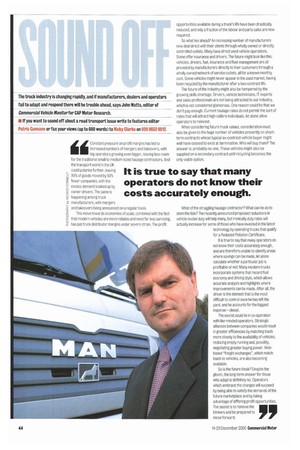d Constant pressure on profit margins has led to
Page 46

If you've noticed an error in this article please click here to report it so we can fix it.
increased numbers of mergers and takeovers, with big operators growing even bigger, leaving less room for the traditional small to medium-sized haulage contractors. And the transport world in the UK could polarise further, leaving
-L-1 90% of goods moved by 50%
5 fewer companies, with the 0 c-' excess demand soaked up by 0 owner-drivers. The same is m happening among truck
..T.' manufacturers, with mergers a
,i and takeovers being announced on a regular basis. ,e This move towards economies of scale, combined with the fact u F..' that modern vehicles are more reliable and need far less servicing, 0
a.has put truck distributor margins under severe strain. The profit
opportunities available during a truck's life have been drastically reduced, and only a fraction of the labour and parts sales are now required.
So what lies ahead? An increasing number of manufacturers now deal direct with their clients through wholly owned or directly controlled outlets. Many have direct used-vehicle operations. Some offer insurance and drivers. The future might look like this: vehicles, drivers, fuel, insurance and fleet management are all provided by manufacturers directly to their customers through a wholly owned network of service outlets, all for a known monthly cost. Some vehicles might never appear in the used market, having been recycled by the manufacturer after a two-contract life.
The future of the industry might also be hampered by the growing skills shortage. Drivers, vehicle technicians, IT experts and sales professionals are not being attracted to our industry, which is not considered glamorous. One reason could be that we don't pay enough. Current haulage rates do not permit the sort of rates that will attract high-calibre individuals, let alone allow operators to reinvest.
When considering future truck values, consideration must also be given to the huge number of vehicles presently on shortterm contracts whose typical ex-contract vehicle buyer might well have ceased to exist at termination. Who will buy them? The answer is: probably no-one. These vehicles might also be supplied on a secondary contract until recycling becomes the only viable option.
What of the struggling haulage contractor? What can he do to stem the tide? The recently announced proposed reductions in vehicle excise duty will help many, but ironically duty rates will actually increase for SOME of those who have invested in the latest technology by operating trucks that qualify for a Reduced Pollution Certificate,
It is true to say that many operators do not know their costs accurately enough, and are therefore unable to identify areas where savings can be made, let alone calculate whether a particular job is profitable or not. Many modern trucks incorporate systems that record fuel economy and driving style, which allows accurate analysis and highlights where improvements can be made. After all, the driver is the element that is the most difficult to control Once he has left the yard, and he accounts for the biggest expense—diesel.
The secret could lie in co-operation with like-minded operators. Strategic alliances between companies would result in greater efficiencies by matching loads more closely to the availability of vehicles, reducing empty running and, possibly, negotiating greater buying power. Webbased "freight exchanges", which match loads to vehicles, are also becoming available.
So is the future bleak? Despite the gloom, the long-term answer for those who adapt is definitely no. Operators which embrace the changes will succeed by being able to satisfy the demands of the future marketplace and by taking advantage of differing profit opportunities. The secret is to remove the blinkers and be prepared to move forward.




































































































